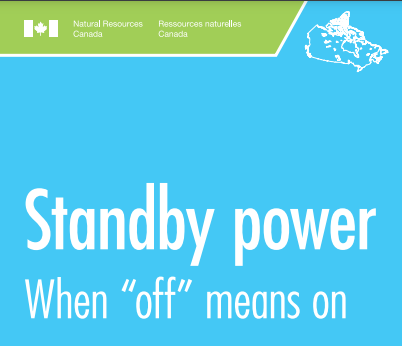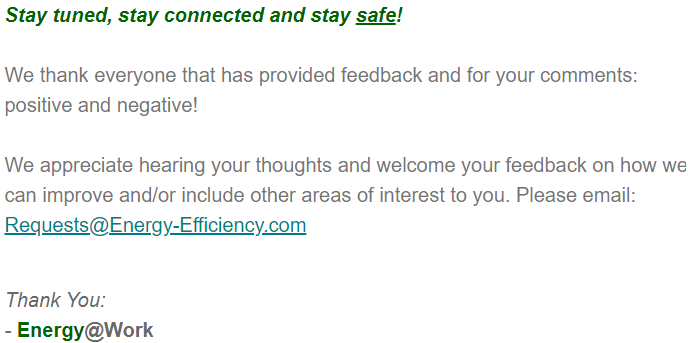Energy@Work’s 5th annual challenge presents this friendly competition!
The challenge aims to help raise awareness of, and mitigate, how much electricity is wasted over the holidays due to:
plug load or what is commonly called “Phantom Power” is a huge opportunity!
systems continuing to run when not needed,
lighting remaining on, particularly accent and interior lobby lighting,
TV screens and monitors have off switches which are rarely used in lieu of standby mode,
exercise equipment “in the ready mode’ but sitting idle
This year’s challenge will occur between 6:00 PM Friday, December 23rd, 2022 - 6:00 AM Tuesday, January 3rd, 2023
Watch our quick video and find out what the Holiday Challenge is all about!
Questions can be directed to: HolidayChallenge@energy-efficiency.com
NRCan has released a Phantom Power brochure to explain what phantom power is and what can be done!
Similar to the Energy@Work Holiday Challenge for Commercial offices, this brochure aims to mitigate unneeded energy use in your home.
The brochure outlines energy savings tips for around the house, including home offices and entertainment centers.
Energy@Work is presenting at this year’s RETScreen World Conference on our use of RETScreen in the work we do.
“Our focus is to share how RETScreen is used in our day-to-day work and become a valuable tool in our energy management toolbox.”
RETScreen has become an important part of Energy@Work’s toolbox in supporting our core services. RETScreen continues to improve and we benefit from the updated features. In 2021, Energy@Work was able to submit 28 projects to Toronto Hydro, who then verified 17,000,000 kWh savings.
At the RETScreen World Conference, Scott Rouse will provide an overview, Edward Newton will share a specific case study example of RETScreen’s capabilities, and Amir Kamandlooie will demonstrate RETScreen’s value used alongside Efficiency Valuation Organization’s (EVO) Guidelines. Using EVO’s guidelines and RETScreen’s capabilities, Amir was able to create mini models and utilize Non routine Events and Adjustments to enable verified electricity savings – even during the pandemic when occupancy was low.
Because of the impressive results and the use of EVO’s Guidelines, the Measurement and Verification Magazine, M and V Focus, featured 2 articles to detail the approach:
We are excited to introduce a new member to our Energy@Work team, Gabriela Guinzani!
Gabriela has moved to Toronto from Brazil to pursue a career in energy management and sustainability in the Ontario Energy sector. Gabriela achieved her bachelor’s degree in chemical engineering in Brazil. Since moving to Toronto, she has graduated from Centennial College where she was able to hone her data analytic skills, gain experience in commissioning and work with smart energy systems.
Gabriela has joined our team as a Jr Energy Analyst and will be working with our clients to help analyze building data and develop energy efficient strategies for future planning.
We look forward to all she will bring to the team!
Barbara Crass wrote an interesting article for the REMI Network discussing an unfortunate trend: how “Outright misrepresentation and subtle insinuation taint environmental claims”.
The momentum climate action has gained in recent years is exciting. Municipalities and companies are making commitments to Net Zero. Investors are looking at Environmental, Social and Governance plans to ensure environmental impacts are being considered for investments. With a pressure on companies to have an ESG plan, we will face greenwashing as a “quick fix” that will inevitably do more harm than good.
Richard Butler, partner at Willms & Shier Environmental Law, was quoted in the article saying: “If you’re going to make a claim, not only should you have proven it, you have to be able to show to the public where and how you’ve proven that claim”.
Disclosing ESG remains the biggest obstacle. Clear guidelines and standards for reporting must be developed but how to make them industry specific and fair across such a large scope, is a challenge.
Butler continued: “Until we get to a point where people can recognize what those individual frameworks require and what the reporting looks like, there’s room for ambiguity in the reporting and greenwashing.”
October 2022 GAM cost is $0.513 billion. This is a 75% increase from September 2022 and an 828% increase comparing October 2022 with August 2022 GA (it was $0.055 billion).
With drastic cost changes monthly, Energy@Work continues to ask “why?”. We provide a monthly review of GAM costs however the reason for the vast cost fluctuation remains unclear.
Energy@Work’s services includes a “GAM coach”. We maintain the importance of a GAM Strategy for Class A and Class B in order to win the (GAM)e. Our collective savings have exceeded $10 million, and we look forward to continuing to assist.
Proposed initiative will help the commercial sector and municipalities, as well as supporting the provincial grid.
Discussion
In early November, Energy@Work’s Scott Rouse had the opportunity to share our experience with sustainability initiatives within our economic climate. The results from our Energy Management Action Plan (E-MAP) were shared:
17 M kWh that Toronto Hydro verified, as well as the many challenges.
The importance of the “how” was shared, i.e.: 3 P’s: People, Process and Products, and how People were the most important.
The Ministry of Energy (MoE) spoke as well and provided an excellent presentation on the challenges ahead of us which prompted us to consider what’s missing: a Commercial Conservation Initiative (CCI).
The MoE began by discussing the surplus electricity coming to an end as early as 2025/26 and their directive to the IESO to secure gas fired generation. Considerable attention was spent on the importance of the Industrial Conservation Initiative (ICI) to help the industrial sector remain competitive. There were many questions, of course, with several focused on decarbonization. The MoE was very careful and specific that carbon was the mandate of the Ministry of Environment. He did mention an IESO study that will be looking into decarbonization.
Scott’s question was more specific to the commercial sector’s commitment to achieving net zero. He asked if net zero is being factored into future planning, since electrification is being considered as a heating option. Although the MoE agreed it was a good question, there were no details. An important point he made was what we all know too well:
“The cheapest energy is the energy that you do not need to make, transmit or distribute”.
Commercial Conservation Initiative (CCI)
With the challenges and opportunities that will be created through net zero commitments, it would make practical sense to develop a CCI program that focuses on kWh reduction. Beyond the obvious economic and environmental benefits, there is the potential for job creation and resilience responses. Commercial customers face a terrible risk if there are electricity interruptions. Instead of adding to increasing demand, the CCI could target the 30% economic opportunity and probably achieve much more. The BOMA average of 24.7 ekWh/sqft demonstrates that many buildings are above that benchmark, this supports the economic potential of the CCI.
Creating the CCI will not be an easy task.
Through experience working with Integrated Resource Planning (IRP), Local Integrated Resource Planning (LIRP) and representing BOMA on the Smart Grid Working group it is apparent that there are many challenges in achieving the required paradigm shift. A paradigm shift is needed to fund conservation equally with supply solutions. However, if, or better said when, this is achieved, it will help overcome the present inequities.
























































































































